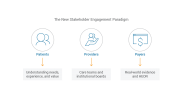It’s accurate to say that the NHS has been experiencing a high and ongoing level of pressure from different angles. With frequent strike actions causing nearly 2 million outpatient appointments and operations to be cancelled since December 2022, and massive labour shortages leaving the NHS short-staffed and overworked, patient waiting lists are ever-increasing. The latest figures for June 2023 show that 7.57 million people are waiting for treatment, with 3 million of these waiting over 18 weeks and 300,000 waiting over a year.
It’s clear that what the NHS is doing right now isn’t working. For the NHS to function effectively, it must begin to embrace a cohesive digital transformation strategy, with previously unsuccessful attempts leaving “substantial variation” between NHS organisations. One particularly important element of this remains to be patient interactions, with the majority of comms remaining paper-based in nature.
Our latest research has revealed that the NHS has spent £103 million on print, pack, and post output in the past 5 years, and they could save an estimated £98 million over a 5-year period by switching to digital alternatives. When placing this into context, this is enough to pay the salary of 3,000 junior doctors. This inefficient allocation of resources could be mitigated, with the funds being redirected to where they matter – supporting frontline staff by reducing shortages and driving the NHS waiting list back down.
However, this move would not only provide cost savings, but significant carbon reduction too. The NHS could cut their carbon footprint, feasibly achieving 504 tonnes of carbon savings every year by shifting to digital communication solutions. This is the equivalent of driving 1.6 million km in a petrol car. When you consider that it only takes 40,075km to drive around the entire world, you can see how the benefits would significantly stack up. But how can the NHS avoid the mistakes of the past and implement a solution that works?
When considering how patients want to be communicated with, our consumer knowledge report revealed that 40% of people from all generations preferred to interact with businesses over email. With many people holding their email addresses for over ten years, it is considered the channel of choice for both business and personal use. This is thanks largely to its high level of efficiency in comparison to postal comms, with email remaining unaffected by postal strikes that can add days to business-critical processes. Outbound emails can also be automated to help reserve time for more important tasks and reduce the risk of important communications not being sent out due to time constraints. Not to mention that with secure email encryption solutions now readily available on the market, email can also be considered one of the most secure methods of transferring sensitive information – especially healthcare data.
However, it’s important to remember that providing a digital solution alone will not be enough. The NHS must consider how best to undergo digital transformation without falling prey to digital exclusion. Many individuals in the UK may not have the digital skills necessary to use an online communication offering, some may not have access to the internet at all, and others may just be reluctant to use a solution they are unfamiliar with.
While choosing something familiar and well-utilised like email would help to bridge this gap, it’s vital to remember that there is not a one-size-fits-all approach, and the NHS must acknowledge this before it can fully embark on a digital transformation journey. To ensure that no one is left behind, the NHS should make sure that any individuals who are vulnerable to digital exclusion are supported, ensuring that the new, digital NHS is a hub for everyone. Digitising their communications and making the move away from postal communication is just one step of this journey and there is still a long way to go before the NHS’ digital transformation journey is complete.
By Paul Holland, CEO at Beyond Encryption





